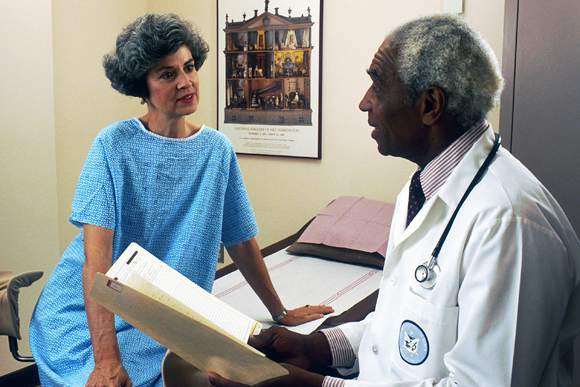User login
Postmastectomy radiotherapy should not be routinely recommended for breast cancer patients with microscopic nodal metastases (N1mic) and T1-2 tumors, according to new findings presented at the symposium.
In patients with T1-2, N1 disease who were treated with standard therapies, the study authors found that overall, there were low rates of locoregional failure. Dr. Lonika Majithia of Ohio State University, Columbus, and colleagues, reported that “patients with N1mic disease had no locoregional failure events and improved overall survival, compared with patients with macrometastases.”
The indications for postmastectomy radiotherapy have expanded to include patients with one to three axillary nodal metastases, note the authors, and with improvements in diagnostic evaluation, an increasing number of N1mic are being detected. Therefore, the challenge facing oncologists now is if the risk posed by N1mic warrants routine delivery of postmastectomy radiotherapy.
The authors identified 550 eligible patients from a prospectively maintained cancer registry, who had a 5-year median follow-up. All patients had pathologic T1-2N1 breast cancer and were treated with an initial mastectomy and adjuvant systemic therapy from 2000 to 2013.
The primary endpoint of the study was locoregional failure, defined as a recurrence in either the ipsilateral chest wall or regional lymphatics (axillary, internal mammary, or supraclavicular). Secondary endpoints included disease-free survival and overall survival.
The majority of patients in the cohort had received chemotherapy (78%; n = 428) and antiendocrine therapy (70%; n = 385), while 15% (n = 82) had received postmastectomy radiation. Among the patients with N1mic disease, 81 had 1+ node, 13 had 2+ nodes, and 1 had 3+ nodes.
The 5-year rate of locoregional failure was 0% for patients with N1mic disease, as compared with 4.6% for those with macrometastases (P = .84). For the entire patient cohort, the 5-year locoregional failure rate was 3.9%. For patients with 1+, 2+, and 3+ nodes, the 5-year rate was 2.6%, 4.7%, and 6.4%, respectively (P = .79).
The authors observed that patients with N1mic disease had a trend towards improved disease-free survival (91.6% vs. 82.3%; P = .07) as well as significantly improved overall survival (96.9% vs. 87.6%; P = .03), as compared with patients with macrometastases.
Postmastectomy radiotherapy should not be routinely recommended for breast cancer patients with microscopic nodal metastases (N1mic) and T1-2 tumors, according to new findings presented at the symposium.
In patients with T1-2, N1 disease who were treated with standard therapies, the study authors found that overall, there were low rates of locoregional failure. Dr. Lonika Majithia of Ohio State University, Columbus, and colleagues, reported that “patients with N1mic disease had no locoregional failure events and improved overall survival, compared with patients with macrometastases.”
The indications for postmastectomy radiotherapy have expanded to include patients with one to three axillary nodal metastases, note the authors, and with improvements in diagnostic evaluation, an increasing number of N1mic are being detected. Therefore, the challenge facing oncologists now is if the risk posed by N1mic warrants routine delivery of postmastectomy radiotherapy.
The authors identified 550 eligible patients from a prospectively maintained cancer registry, who had a 5-year median follow-up. All patients had pathologic T1-2N1 breast cancer and were treated with an initial mastectomy and adjuvant systemic therapy from 2000 to 2013.
The primary endpoint of the study was locoregional failure, defined as a recurrence in either the ipsilateral chest wall or regional lymphatics (axillary, internal mammary, or supraclavicular). Secondary endpoints included disease-free survival and overall survival.
The majority of patients in the cohort had received chemotherapy (78%; n = 428) and antiendocrine therapy (70%; n = 385), while 15% (n = 82) had received postmastectomy radiation. Among the patients with N1mic disease, 81 had 1+ node, 13 had 2+ nodes, and 1 had 3+ nodes.
The 5-year rate of locoregional failure was 0% for patients with N1mic disease, as compared with 4.6% for those with macrometastases (P = .84). For the entire patient cohort, the 5-year locoregional failure rate was 3.9%. For patients with 1+, 2+, and 3+ nodes, the 5-year rate was 2.6%, 4.7%, and 6.4%, respectively (P = .79).
The authors observed that patients with N1mic disease had a trend towards improved disease-free survival (91.6% vs. 82.3%; P = .07) as well as significantly improved overall survival (96.9% vs. 87.6%; P = .03), as compared with patients with macrometastases.
Postmastectomy radiotherapy should not be routinely recommended for breast cancer patients with microscopic nodal metastases (N1mic) and T1-2 tumors, according to new findings presented at the symposium.
In patients with T1-2, N1 disease who were treated with standard therapies, the study authors found that overall, there were low rates of locoregional failure. Dr. Lonika Majithia of Ohio State University, Columbus, and colleagues, reported that “patients with N1mic disease had no locoregional failure events and improved overall survival, compared with patients with macrometastases.”
The indications for postmastectomy radiotherapy have expanded to include patients with one to three axillary nodal metastases, note the authors, and with improvements in diagnostic evaluation, an increasing number of N1mic are being detected. Therefore, the challenge facing oncologists now is if the risk posed by N1mic warrants routine delivery of postmastectomy radiotherapy.
The authors identified 550 eligible patients from a prospectively maintained cancer registry, who had a 5-year median follow-up. All patients had pathologic T1-2N1 breast cancer and were treated with an initial mastectomy and adjuvant systemic therapy from 2000 to 2013.
The primary endpoint of the study was locoregional failure, defined as a recurrence in either the ipsilateral chest wall or regional lymphatics (axillary, internal mammary, or supraclavicular). Secondary endpoints included disease-free survival and overall survival.
The majority of patients in the cohort had received chemotherapy (78%; n = 428) and antiendocrine therapy (70%; n = 385), while 15% (n = 82) had received postmastectomy radiation. Among the patients with N1mic disease, 81 had 1+ node, 13 had 2+ nodes, and 1 had 3+ nodes.
The 5-year rate of locoregional failure was 0% for patients with N1mic disease, as compared with 4.6% for those with macrometastases (P = .84). For the entire patient cohort, the 5-year locoregional failure rate was 3.9%. For patients with 1+, 2+, and 3+ nodes, the 5-year rate was 2.6%, 4.7%, and 6.4%, respectively (P = .79).
The authors observed that patients with N1mic disease had a trend towards improved disease-free survival (91.6% vs. 82.3%; P = .07) as well as significantly improved overall survival (96.9% vs. 87.6%; P = .03), as compared with patients with macrometastases.
FROM THE 2015 ASCO BREAST CANCER SYMPOSIUM
Key clinical point: Radiotherapy following mastectomy should not be routinely recommended for breast cancer patients with microscopic nodal metastases (N1mic) and T1-2 tumors.
Major finding: The 5-year rate of locoregional failure was 0% for patients with N1mic disease vs. 4.6% in those with macrometastases (P = .84).
Data source: 550 eligible patients who met the inclusion criteria were identified from a prospectively maintained cancer registry.
Disclosures: No conflicts of interest were disclosed.

